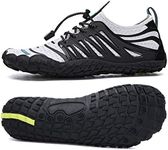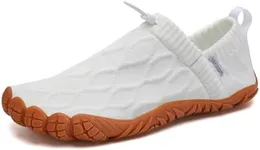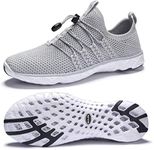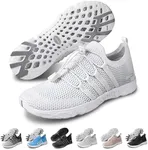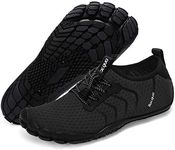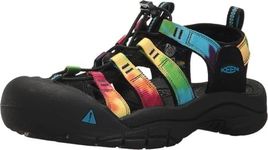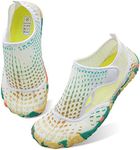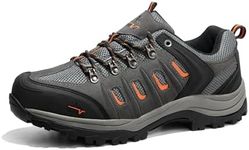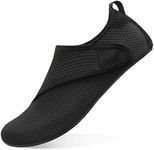Buying Guide for the Best Water Hiking Shoes
When choosing water hiking shoes, it's important to find a pair that offers the right balance of comfort, durability, and functionality. These shoes are designed to handle wet and rugged terrains, so they need to provide good traction, quick drying capabilities, and support. Understanding the key specifications will help you make an informed decision and ensure you get the best fit for your needs.MaterialThe material of water hiking shoes is crucial because it affects durability, comfort, and drying time. Common materials include mesh, neoprene, and synthetic fabrics. Mesh is lightweight and breathable, allowing for quick drying, while neoprene offers better insulation and protection. Synthetic fabrics often provide a balance between durability and breathability. Choose a material based on the conditions you'll be hiking in; for warm climates, opt for breathable mesh, and for colder or more rugged conditions, consider neoprene or durable synthetic options.
TractionTraction refers to the grip the shoes provide on various surfaces, which is essential for safety and stability. Water hiking shoes typically have rubber outsoles with specialized tread patterns to enhance grip on wet and slippery surfaces. Look for shoes with deep lugs and multi-directional patterns for better traction. If you plan to hike on rocky or uneven terrain, prioritize shoes with aggressive tread patterns. For smoother trails, a moderate tread pattern will suffice.
DrainageDrainage is the shoe's ability to expel water quickly, preventing your feet from staying wet and uncomfortable. Good water hiking shoes have drainage ports or channels that allow water to escape easily. This feature is important to keep your feet dry and reduce the risk of blisters. If you expect to frequently cross streams or hike in wet conditions, prioritize shoes with efficient drainage systems. For less frequent water exposure, basic drainage features may be adequate.
Fit and ComfortFit and comfort are essential for any hiking shoe, but especially for water hiking shoes, as wet conditions can cause discomfort and blisters. Look for shoes with a snug fit that still allows for some movement. Consider shoes with adjustable features like laces or straps to customize the fit. Try on shoes with the socks you plan to wear while hiking to ensure a proper fit. If you have wide or narrow feet, look for brands that offer different width options.
Support and CushioningSupport and cushioning are important for protecting your feet and providing comfort over long hikes. Water hiking shoes should have good arch support and a cushioned midsole to absorb impact. EVA foam is a common material used for cushioning due to its lightweight and shock-absorbing properties. If you have specific foot issues, such as high arches or flat feet, look for shoes with additional support features. For general use, a moderate level of cushioning and support will usually be sufficient.
WeightThe weight of the shoes can affect your hiking experience, especially over long distances. Lighter shoes reduce fatigue and make it easier to move quickly, while heavier shoes often provide more durability and protection. Consider the type of hiking you'll be doing; for long, strenuous hikes, opt for lightweight shoes to conserve energy. For shorter hikes or more rugged terrain, a slightly heavier shoe with added protection may be more suitable.
